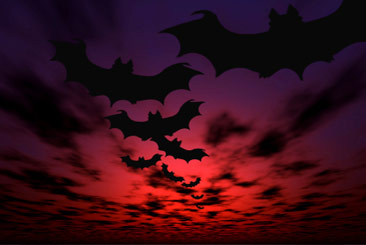|
|
| Eek! It's the B.A.T. |
| By Joe Bouchard |
| Published: 11/10/2008 |
 I sit nervously near the scene of the incident mere moments after it occurred. As I write these notes, I am amazed at how unprepared we were.
I sit nervously near the scene of the incident mere moments after it occurred. As I write these notes, I am amazed at how unprepared we were.The event was unexpected and discomforting, leaving four people nervous, clumsy, full of adrenaline, and confused. Notions of comfort and safety were shattered in an instant. A presence had breached our safe zone. It sounds like this is some sort of post mortem of a crime, terrorist act or some sort of calamity. However, the source of the trepidation was a single brown bat. Specifically, when I cranked open our patio umbrella to shield our sitting area from the 10 a.m. sun, I discovered a single bat clinging to the fabric. Its slumber disturbed, the bat flew in an awkward, though seemingly menacing, manner. Then the human pandemonium ensued. The four of us present did not know what to do, where to run, or how to act. From a distance, we must have looked foolish. Perhaps oblivious to our fumblings, the bat settled in the dark confines of a pine tree. It was a telling turn of events that four intelligent adults were rendered useless by a few ounces of flying fury. I admit that I am not proud that a simple bat in broad daylight took me by surprise. However, I respectfully invite readers to place themselves in my situation at the time. There is, of course, a corrections lesson in this story. There are hidden things in our work environment that, once discovered, leave us uncomfortable and momentarily helpless. A lack of experience for a new and unsettling event often leaves us unprepared. That line of thinking lead me to form the “Bad Activity Theory.” The “Bad Activity Theory” is the notion that corrections staff can be rendered frozen or momentarily indecisive by the newness and shock of a surprising event. The catalyst can be a hitherto undetected illegal activity, for example, or discovering an inmate where you never thought anyone would dare to go. In this theory, the incident is surprising. It is outside the realm of normal activities and beyond the discoverer’s experience. We are trained to look for the unexpected, but we can still be surprised. For example, we can conceptualize the discovery of a cell phone concealed in an inmate’s property. Yet, when we find one for the first time, we are momentarily shocked. Optimally, this is when the training kicks in, and we report and secure the contraband. Unless we excel in hypothetical thinking, we don’t think of things when they are hidden. Out of sight is out of mind. But our blissful ignorance can be shattered in an instant. To soften the shock, and in the spirit of keeping our facilities safe, we must think out of the ordinary. It is always useful to engage ourselves in a game of “what if.” For most of us, analysis follows the event, as we note the ingenuity of the hiding place. In this way, we look for the next crime scene based on where the last one occurred. We add the new hiding place to our search list. As we analyze, we wonder how long the illegal activity may have gone on. We must remember that not all concealment tricks and illegal activities are discovered immediately. And because of that, other areas and agencies may have policies in place to hinder such activities. The experience of others can lead to more discoveries. Discomfort is potentially good. This is especially true if the initial reaction does not endanger the person who discovers the “bad activity.” It pulls us away from our normal routine and allows us to plan for future shocking events. We are more likely to think of how things can be rather than how they normally are. The goals of enterprising inmates and corrections staff during a “bad activity” are always at odds. The prisoner’s aim is to profit from our lack of watchfulness. Our goal is to hinder the activity in the name of safety for staff, inmates, and the public. We must, in other words, expect the unexpected. As I write this, the sun climbs higher towards its noon position. As far as I can tell, there is no creature clinging to any of my patio furniture. I realize that the bat may or may not return. It is true that I may never encounter the same sort of thing again. However, I will employ caution from now on when I open the umbrella. I realize that a simple bat sighting is not a sign of infestation. This is in no way as dangerous as illegal activities in a prison. But from the bat incident I realize this: Notions of safety are tempered by experience. Regular Corrections.com columnist Joe Bouchard is a librarian at Baraga Maximum Correctional Facility within the Michigan Department of Corrections. He also is a member of the Board of Experts for “The Corrections Professional” and an instructor of Corrections and Psychology for Gogebic Community College. You can reach him at (906) 353-7070 ext 1321. These are the opinions of Joe Bouchard, a librarian employed with the Michigan Department of Corrections, and not necessarily the opinions of the MIDOC. The MIDOC is not responsible for the content or its accuracy. Other articles by Bouchard: Thoughts on “closed” economic systems Busting through the sphere of negativity |



Comments:
No comments have been posted for this article.
Login to let us know what you think